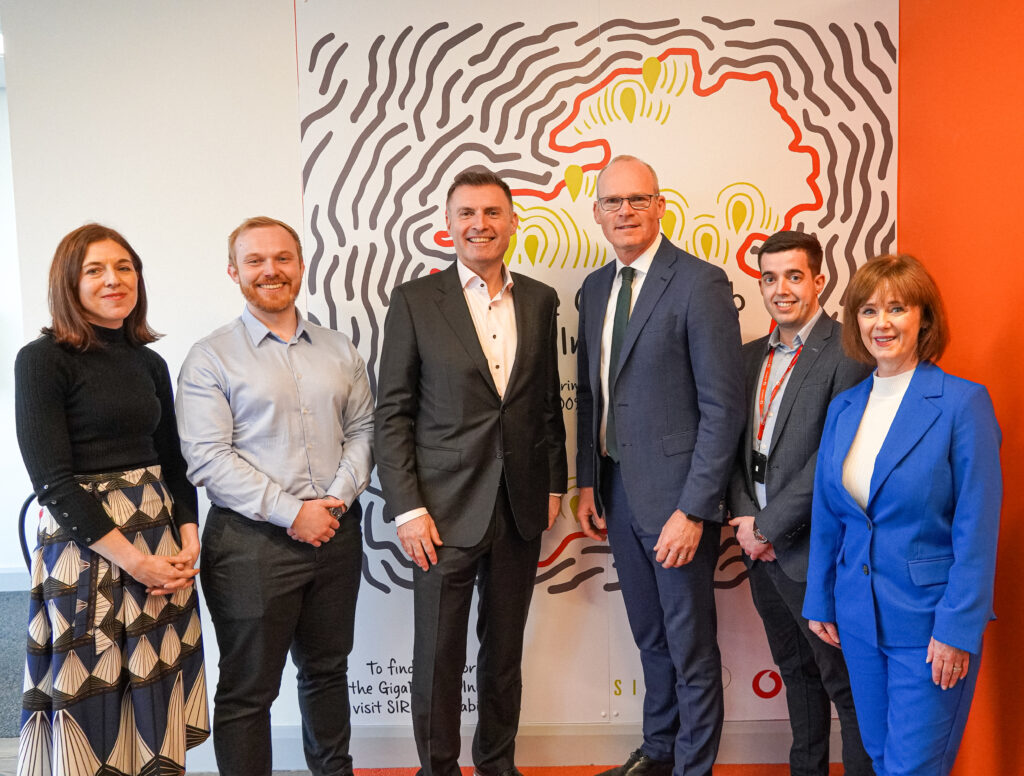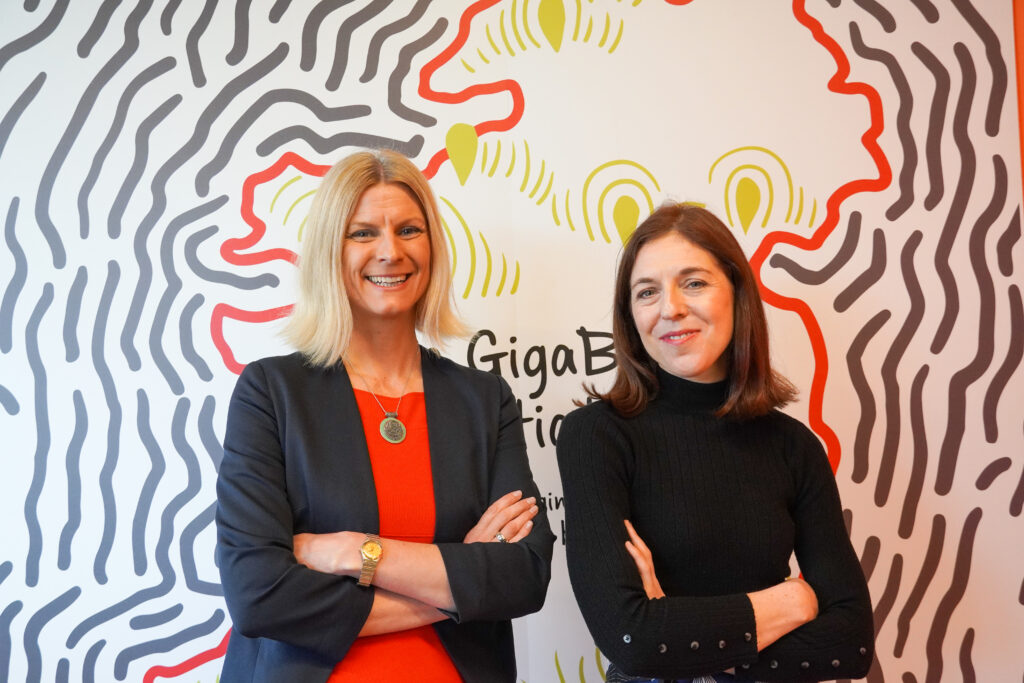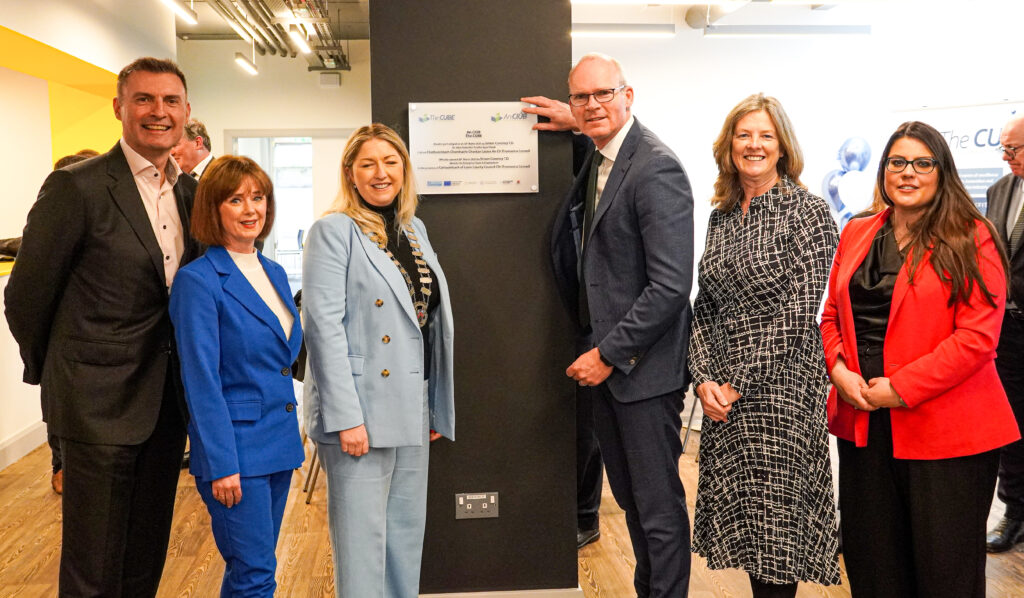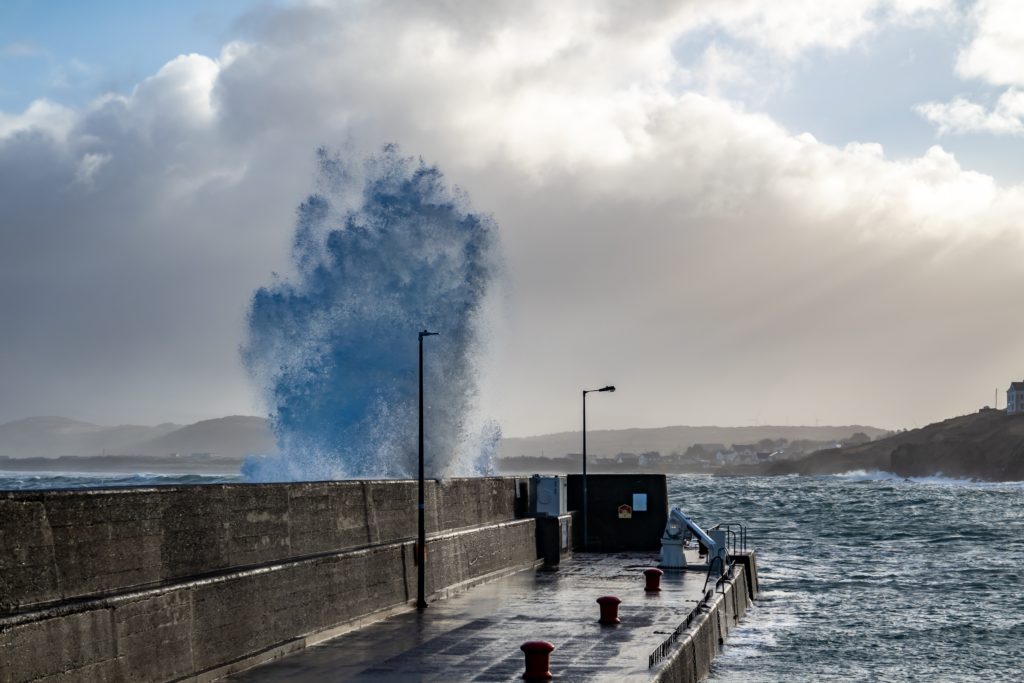
On 1 June last, SIRO launched its’ 10 Gigabit (10G) enabled broadband network in Galway city. The first city in Ireland to have this high speed, large bandwidth network at its disposal.
At the end August, SIRO’s entire fibre broadband network was upgraded to 10 Gigabits. This €10 million, 15-month upgrade project includes our full existing SIRO network, i.e., 450,000+ premises we have already passed and the further 320,000 we are in the process of passing right now.
10G: what is it?
From the middle of last year, SIRO began the process of upgrading its’ existing network to a 10 Gigabit network using XGS-PON technology.
G-PON stands for Gigabit PON or 1 Gigabit PON.
The “X” in XGS represents the number 10, and the letter “S” stands for symmetrical, XGS-PON = 10 Gigabit Symmetrical PON.
The upgrade allows SIRO to turbo-charge our existing network from a one Gigabit network to a network providing up to 10G connections which are symmetrical (same upload and download speeds), much more reliable, with lower latencies and better security.
The point of a 10G network is the flexibility to scale up seamlessly as your data demands grow. One Gigabit to two, four, six Gigabits and so on
What can it do?
One of the most prominent and headline grabbing aspects of 10 G is speed, specifically speed of data transfer. 10 Gbps lets you transfer at a rate of 1.25 GB/s when you copy a file to another computer across the SIRO network. This equates to sending a 20 GB file in under 20 seconds.

At SIRO we know, that at least for the short-to-medium term, end users of this much larger bandwidth will be enterprise/business users vs. residential consumers.
It makes sense.
It is businesses, whether small or large, who typically move large data sets. However, the number of businesses who falls into this category is not as niche as it once might have been. As ever more intensive applications run on our servers or are stored in the Cloud, the amount of data created, stored and transferred increases each day. Add in the growing automation of once manual tasks and the need for high-speed internet as the key enabler of these processes becomes clear.
10G will become the technology platform for this phase of digital adaptation across the world. It will ensure that technology in our lives becomes even more embedded and integrated
Speed and bandwidth are also important for business where large numbers of colleagues and clients need to connect at once. Both now have an expectation of being able to access services when they require them and that this access is dependable and consistent.

Business, for reasons of productivity, reputation and of course the bottom line, cannot afford to have any bottlenecks in their connectivity which can hold their business back.
Businesses with many employees and multiple clients all logging on at the same time are obvious candidates for much higher speeds. Yet over recent years as our use of digital technologies has grown, it has spawned new types of business which are equally heavy data users.
Businesses in the creative sector is one example. While they may not be big in terms of employee head count, they are big users of data. Think content creators in advertising, digital or marketing agencies, animators, film or videographers, game design – all transferring large files each day. Though smaller companies, the creative sector in its’ totality is a significant sector, employing up to 5% of the Irish workforce or about 100,000.
Do I need 10G?
In truth, it depends.
If you are an individual, doing video editing, streaming, audio production, activities which involve a large amount of data and if your workflow currently lags due to slow speeds, then likely you do need to move up the Gigabit ranks from the standard one Gigabit to higher speeds. The point of a 10G network is the flexibility to scale up seamlessly as your data demands grow. One Gigabit to two, four, six Gigabits and so on.
The use case is much clearer if you are a business or enterprise. If your business has large file sizes to deal; you use HD streaming or your company is growing in terms of capability or headcount, then there is a real risk of congestion on your network necessitating larger bandwidth.
10G will become the technology platform for this phase of digital adaptation across the world.
An important additional benefit of SIRO’s 10G network is affordability. Previously access to high-speed point-to-point (P2P) services was largely just available to very big organisations with substantial IT budgets. With this upgrade SIRO have changed that market limiting dynamic.

A 10 Gigabit Future?
Just as when once the need for one Gigabit broadband met with questions on the use case of that level of bandwidth; some might today ask a similar question of 10 Gigabit broadband.
Those of us who have seen the relentless march of data demands, know better than to ask that question anymore.
Instead, the more pertinent question for business and society to consider are what processes and technologies (many, not yet invented) can this level of bandwidth unlock for the benefit of all?
10G will become the technology platform for this phase of digital adaptation across the world. It will ensure that technology in our lives becomes even more embedded and integrated.
Healthcare professionals will monitor and diagnose their patients remotely in real-time, our students will collaborate and learn not just from their classmates but with other children across the world and virtual and augmented reality (VR and AR) will change many aspects of how we live from retail, to home entertainment, to the world of work.
In SIRO we have always sought to drive innovation in the Irish broadband market to make the probable, possible. Today’s focus may be on 10 Gigabits, but the direction of journey to 25 Gigabits is already coming into view.
To find out if your business can avail of SIRO for Business, please visit
www.siro.ie/search-your-eircode
 Director of The Cube, Caroline Hofman[/caption]
Thursday, 30th March 2023 saw the official opening of the GigaBitHub, The CUBE, by Minister for Enterprise, Trade and Employment, Simon Coveney. The 10,000 square foot Low Carbon Centre of Excellence is a dedicated centre for the development of new business and economic activity. It’s goal is to support and assist a transition to a low carbon economy for County Laois.
Portlaoise Town has been designated as Ireland’s first ‘Low Carbon Town’ which will serve as a roadmap for the development and rollout of similar low carbon initiatives in other towns around the Country.
This low carbon facility is the first of its kind in the region and is located in the heart of Portlaoise’s Cultural Quarter. It will support and stimulate the development of enterprise and jobs in Laois and the Midlands region.
The CUBE is funded by Enterprise Ireland under the Regional Enterprise Development Fund. The project pivots around Government plans and strategic directions, including Project Ireland 2040, the Climate Action Plan to tackle Climate breakdown, and the Midlands Regional Enterprise Plan to 2024.
The Cube is the 18th GigaBitHub to be announced under SIRO and Vodafone’s GigaBitHub initiative and is the first to open under its second phase.
[caption id="attachment_7971" align="aligncenter" width="1024"]
Director of The Cube, Caroline Hofman[/caption]
Thursday, 30th March 2023 saw the official opening of the GigaBitHub, The CUBE, by Minister for Enterprise, Trade and Employment, Simon Coveney. The 10,000 square foot Low Carbon Centre of Excellence is a dedicated centre for the development of new business and economic activity. It’s goal is to support and assist a transition to a low carbon economy for County Laois.
Portlaoise Town has been designated as Ireland’s first ‘Low Carbon Town’ which will serve as a roadmap for the development and rollout of similar low carbon initiatives in other towns around the Country.
This low carbon facility is the first of its kind in the region and is located in the heart of Portlaoise’s Cultural Quarter. It will support and stimulate the development of enterprise and jobs in Laois and the Midlands region.
The CUBE is funded by Enterprise Ireland under the Regional Enterprise Development Fund. The project pivots around Government plans and strategic directions, including Project Ireland 2040, the Climate Action Plan to tackle Climate breakdown, and the Midlands Regional Enterprise Plan to 2024.
The Cube is the 18th GigaBitHub to be announced under SIRO and Vodafone’s GigaBitHub initiative and is the first to open under its second phase.
[caption id="attachment_7971" align="aligncenter" width="1024"] L-R, SIRO Corporate Affairs Director, Amanda Glancy, Charlie Collins, Senior Strategic Partner, VF Business, John Keaney, SIRO CEO, Minister for Enterprise, Trade and Employment, Simon Coveney, Public Sector Account Executive, Ryan Brophy Lisa Corcoran, Head of SME Business, Vodafone Business Ireland[/caption]
Present at the launch included: Minister for Enterprise, Trade and Employment, Simon Conveney, Minister of State for the Department of Agriculture, Food and the Marine, Senator Pippa Hackett, Cathaoirleach of Laois County Council, Thomasina Connell, SIRO CEO, John Keaney, Cube Tenants, including FRS Recruitment, WrkWrk, and Midlands.ie, Laois County Council CEO, John Mullholland, Enterprise Ireland Divisional Manager, Carol Gibbins, and Head of SME Business at Vodafone Business Ireland, Lisa Corcoran.
[caption id="attachment_7970" align="aligncenter" width="1024"]
L-R, SIRO Corporate Affairs Director, Amanda Glancy, Charlie Collins, Senior Strategic Partner, VF Business, John Keaney, SIRO CEO, Minister for Enterprise, Trade and Employment, Simon Coveney, Public Sector Account Executive, Ryan Brophy Lisa Corcoran, Head of SME Business, Vodafone Business Ireland[/caption]
Present at the launch included: Minister for Enterprise, Trade and Employment, Simon Conveney, Minister of State for the Department of Agriculture, Food and the Marine, Senator Pippa Hackett, Cathaoirleach of Laois County Council, Thomasina Connell, SIRO CEO, John Keaney, Cube Tenants, including FRS Recruitment, WrkWrk, and Midlands.ie, Laois County Council CEO, John Mullholland, Enterprise Ireland Divisional Manager, Carol Gibbins, and Head of SME Business at Vodafone Business Ireland, Lisa Corcoran.
[caption id="attachment_7970" align="aligncenter" width="1024"] L-R, Minister of State for the Department of Agriculture, Food and the Marine, Senator Pippa Hackett and Corporate Affairs Director at SIRO, Amanda Glancy[/caption]
Speaking on the announcement, the following comments were made:
Speaking at the opening Minister for Enterprise, Trade and Employment Simon Coveney TD said:
L-R, Minister of State for the Department of Agriculture, Food and the Marine, Senator Pippa Hackett and Corporate Affairs Director at SIRO, Amanda Glancy[/caption]
Speaking on the announcement, the following comments were made:
Speaking at the opening Minister for Enterprise, Trade and Employment Simon Coveney TD said:
 L-R SIRO CEO John Keaney, Head of SME Business, Lisa Corcoran, Cathaoirleach, Cllr. Thomasina Connell, Minister for Enterprise, Trade and Employment, Simon Coveney, Divisional Manager & Head of Regions and Local Enterprise, Enterprise Ireland, Carol Gibbins, and Director of The Cube, Caroline Hofman[/caption]
Cathaoirleach of Laois County Council, Thomasina Connell added:
L-R SIRO CEO John Keaney, Head of SME Business, Lisa Corcoran, Cathaoirleach, Cllr. Thomasina Connell, Minister for Enterprise, Trade and Employment, Simon Coveney, Divisional Manager & Head of Regions and Local Enterprise, Enterprise Ireland, Carol Gibbins, and Director of The Cube, Caroline Hofman[/caption]
Cathaoirleach of Laois County Council, Thomasina Connell added:


 siro sustainability[/caption]
siro sustainability[/caption]




 SIRO is a joint venture company between ESB and Vodafone, founded in 2015. SIRO’s fibre broadband network is built on the ESB electricity infrastructure, trusted for its reliability and resilience. Overall, the company is investing more than €1 billion in delivering high speed, future proofed broadband across Ireland.
Commenting on the announcement, SIRO’s CEO, John Keaney, said:
SIRO is a joint venture company between ESB and Vodafone, founded in 2015. SIRO’s fibre broadband network is built on the ESB electricity infrastructure, trusted for its reliability and resilience. Overall, the company is investing more than €1 billion in delivering high speed, future proofed broadband across Ireland.
Commenting on the announcement, SIRO’s CEO, John Keaney, said:
 With one of the busiest shopping days of the year, Black Friday, fast approaching, it’s time to start researching where to shop online and how to get the best deals.
Black Friday, once a US tradition, now a global phenomenon is where deal-savvy customers piled into shopping malls after Thanksgiving ready to buy discounted goods for Christmas.
Now, in Ireland, it’s certainly on consumers’ minds. RTE noted that Google searches for "Black Friday" had increased by 138% from 2020 to
With one of the busiest shopping days of the year, Black Friday, fast approaching, it’s time to start researching where to shop online and how to get the best deals.
Black Friday, once a US tradition, now a global phenomenon is where deal-savvy customers piled into shopping malls after Thanksgiving ready to buy discounted goods for Christmas.
Now, in Ireland, it’s certainly on consumers’ minds. RTE noted that Google searches for "Black Friday" had increased by 138% from 2020 to 
 Barry has spent over thirty-five years working in ICT. He started as a Trainee Programmer in the Northern Ireland Civil Service and progressed through various roles to eventually become the Director of ICT Shared Services and Strategy for the NI Government. Barry has been CIO for the Irish Government since April 2016 with the primary task of taking forward the Public Service ICT and eGovernment Strategies. These set out ambitions for developing the use of shared services, digital services and data to better serve the people of Ireland and ensure that Ireland is well-placed to benefit from European initiatives such as the Digital Single Market.
Barry has spent over thirty-five years working in ICT. He started as a Trainee Programmer in the Northern Ireland Civil Service and progressed through various roles to eventually become the Director of ICT Shared Services and Strategy for the NI Government. Barry has been CIO for the Irish Government since April 2016 with the primary task of taking forward the Public Service ICT and eGovernment Strategies. These set out ambitions for developing the use of shared services, digital services and data to better serve the people of Ireland and ensure that Ireland is well-placed to benefit from European initiatives such as the Digital Single Market.

 On 1 June last, SIRO launched its’ 10 Gigabit (10G) enabled broadband network in Galway city. The first city in Ireland to have this high speed, large bandwidth network at its disposal.
At the end August, SIRO’s entire fibre broadband network was upgraded to 10 Gigabits. This €10 million, 15-month upgrade project includes our full existing SIRO network, i.e., 450,000+ premises we have already passed and the further 320,000 we are in the process of passing right now.
On 1 June last, SIRO launched its’ 10 Gigabit (10G) enabled broadband network in Galway city. The first city in Ireland to have this high speed, large bandwidth network at its disposal.
At the end August, SIRO’s entire fibre broadband network was upgraded to 10 Gigabits. This €10 million, 15-month upgrade project includes our full existing SIRO network, i.e., 450,000+ premises we have already passed and the further 320,000 we are in the process of passing right now.
 At SIRO we know, that at least for the short-to-medium term, end users of this much larger bandwidth will be enterprise/business users vs. residential consumers.
It makes sense.
It is businesses, whether small or large, who typically move large data sets. However, the number of businesses who falls into this category is not as niche as it once might have been. As ever more intensive applications run on our servers or are stored in the Cloud, the amount of data created, stored and transferred increases each day. Add in the growing automation of once manual tasks and the need for high-speed internet as the key enabler of these processes becomes clear.
At SIRO we know, that at least for the short-to-medium term, end users of this much larger bandwidth will be enterprise/business users vs. residential consumers.
It makes sense.
It is businesses, whether small or large, who typically move large data sets. However, the number of businesses who falls into this category is not as niche as it once might have been. As ever more intensive applications run on our servers or are stored in the Cloud, the amount of data created, stored and transferred increases each day. Add in the growing automation of once manual tasks and the need for high-speed internet as the key enabler of these processes becomes clear.
 Business, for reasons of productivity, reputation and of course the bottom line, cannot afford to have any bottlenecks in their connectivity which can hold their business back.
Businesses with many employees and multiple clients all logging on at the same time are obvious candidates for much higher speeds. Yet over recent years as our use of digital technologies has grown, it has spawned new types of business which are equally heavy data users.
Businesses in the creative sector is one example. While they may not be big in terms of employee head count, they are big users of data. Think content creators in advertising, digital or marketing agencies, animators, film or videographers, game design – all transferring large files each day. Though smaller companies, the creative sector in its’ totality is a significant sector, employing up to 5% of the Irish workforce or about 100,000.
Business, for reasons of productivity, reputation and of course the bottom line, cannot afford to have any bottlenecks in their connectivity which can hold their business back.
Businesses with many employees and multiple clients all logging on at the same time are obvious candidates for much higher speeds. Yet over recent years as our use of digital technologies has grown, it has spawned new types of business which are equally heavy data users.
Businesses in the creative sector is one example. While they may not be big in terms of employee head count, they are big users of data. Think content creators in advertising, digital or marketing agencies, animators, film or videographers, game design – all transferring large files each day. Though smaller companies, the creative sector in its’ totality is a significant sector, employing up to 5% of the Irish workforce or about 100,000.



 SIRO, a joint venture between ESB and Vodafone, is currently rolling out a 100% fibre broadband network across 154 towns and cities across Ireland, with services currently available to 450,000+ premises and reaching 770,000 premises over the next four years.
In October 2021, SIRO launched 2 Gigabit speeds for the residential market. Today’s announcement of 10 Gigabits is initially focused on the enterprise market. The latter have a need to progressively scale up their bandwidth from 2 Gigabits up to 10 Gigabits in the short to medium term.
The upgrade to 10 Gigabits reflects SIRO’s ambition to continuously bring innovation to the Irish broadband market. SIRO is Ireland’s sole open-access wholesale-only broadband operator and was first to introduce 1 Gigabit broadband to Irish homes. It is now stretching its offering further with speeds of 2 Gigabits for residential and up to 10 Gigabits for enterprise customers, respectively.
The benefits of multi-gigabit speeds include:
Ensure fastest speeds: Symmetrical speeds up to ten times faster than the best standard currently available of up to 1 Gigabit. A 10 Gigabit connection can transfer 1 Gigabit of data in 0.8 seconds or upload a file of 20 Gigabits in under 20 seconds.
Provide scalable connectivity: A future-proofed connection to support the increasing number of connected devices used by businesses.
Enhance cyber protection: Enhanced data and network protection by facilitating network management systems which reduce cybersecurity risks.
Support new technologies: The bandwidth to integrate emerging technologies, including artificial intelligence, virtual reality, 3D technology or voice recognition tools.
Commenting on the announcement, SIRO CEO, John Keaney, said:
“For SIRO, completing our transition to a 10 Gigabit-enabled network is about ensuring we continue to lead the market in terms of delivering on Ireland’s future broadband needs for the decades ahead.
“All aspects of business processes and operations are increasingly digitised. Reliable and future proofed connectivity is the foundation upon which they all rest.
“This upgrade gives enterprises the opportunity to plan and scale up their bandwidth requirements as their data demands and business requirements grow.
Rather than wait for the broadband infrastructure to catch up, businesses can now have the certainty that they can access higher speeds and capacity as and when they need it,” added Mr. Keaney.
To find out if you can avail of 10 Gigabit today, check your Eircode today!
[lookup_modal type="eircode" button-text="Search Your Eircode Today" position="mid" title="Search Your Eircode Today"]
SIRO, a joint venture between ESB and Vodafone, is currently rolling out a 100% fibre broadband network across 154 towns and cities across Ireland, with services currently available to 450,000+ premises and reaching 770,000 premises over the next four years.
In October 2021, SIRO launched 2 Gigabit speeds for the residential market. Today’s announcement of 10 Gigabits is initially focused on the enterprise market. The latter have a need to progressively scale up their bandwidth from 2 Gigabits up to 10 Gigabits in the short to medium term.
The upgrade to 10 Gigabits reflects SIRO’s ambition to continuously bring innovation to the Irish broadband market. SIRO is Ireland’s sole open-access wholesale-only broadband operator and was first to introduce 1 Gigabit broadband to Irish homes. It is now stretching its offering further with speeds of 2 Gigabits for residential and up to 10 Gigabits for enterprise customers, respectively.
The benefits of multi-gigabit speeds include:
Ensure fastest speeds: Symmetrical speeds up to ten times faster than the best standard currently available of up to 1 Gigabit. A 10 Gigabit connection can transfer 1 Gigabit of data in 0.8 seconds or upload a file of 20 Gigabits in under 20 seconds.
Provide scalable connectivity: A future-proofed connection to support the increasing number of connected devices used by businesses.
Enhance cyber protection: Enhanced data and network protection by facilitating network management systems which reduce cybersecurity risks.
Support new technologies: The bandwidth to integrate emerging technologies, including artificial intelligence, virtual reality, 3D technology or voice recognition tools.
Commenting on the announcement, SIRO CEO, John Keaney, said:
“For SIRO, completing our transition to a 10 Gigabit-enabled network is about ensuring we continue to lead the market in terms of delivering on Ireland’s future broadband needs for the decades ahead.
“All aspects of business processes and operations are increasingly digitised. Reliable and future proofed connectivity is the foundation upon which they all rest.
“This upgrade gives enterprises the opportunity to plan and scale up their bandwidth requirements as their data demands and business requirements grow.
Rather than wait for the broadband infrastructure to catch up, businesses can now have the certainty that they can access higher speeds and capacity as and when they need it,” added Mr. Keaney.
To find out if you can avail of 10 Gigabit today, check your Eircode today!
[lookup_modal type="eircode" button-text="Search Your Eircode Today" position="mid" title="Search Your Eircode Today"]